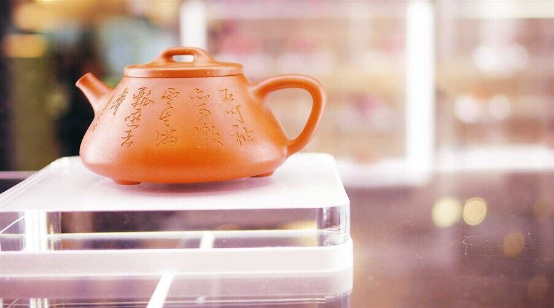- 中文
- EN
- Français
- 日本語
- 한국어
- 繁體中文
Exhibition Highlights Place of Tea in Chinese Life

A visitor takes a look at the exhibits on display at the Chinese Tea Life Art Exhibition, which features ancient tea wares and documents, modern tea pots, as well as several rooms devoted to the role of tea in daily life.
CHINESE tea culture isn’t only about tea leaves. It’s also about the wares, traditions and even art and literature. A new exhibition in Hangzhou explains how tea is intimately connected with people’s lives, both now and in the past.
The practice of drinking tea has a long history in China. According to popular legend, tea was discovered over 4,000 years ago. The beverage is deeply woven into the history and culture of the country, and is considered a necessity of Chinese life.
The Chinese Tea Life Art Exhibition, on view now at the China Craft Art Museum, includes ancient tea wares and documents, modern tea pots, as well as several rooms devoted to the role of tea in daily life.
“Compared to Japanese sado, which concentrates on ceremonies and rituals, Chinese tea culture is more about the relationship between the beverage and life,” said Hang Jian, director of the museum, located in the China Academy of Art’s Xiangshan campus.
“The exhibition attempts to describe how tea wares have developed through history, and into today,” said Yuan Youmin, designer of the exhibition space. Yuan was also the designer behind the logo for the G20 Summit held in Hangzhou in last September.
The first piece in the exhibition is, perhaps unexpectedly, a cottage. The structure was created based on a painting by scholar Tang Yin (1470–1524) which shows how ancient Chinese people made tea. A wall-sized duplicate of the painting is next to the cottage for comparison.
The image illustrates figures resting in a cottage as they brew and enjoy tea. The real cottage contains a terracotta figurine and a series of tea sets, which were unearthed from tombs dating to the Tang Dynasty (AD 618-907). They are so far the country’s earliest tea-set burial objects.
The relics are decorative and hence of miniature size. The figurine is shown boiling tea with an oven. In front of it are a set of tiny tea wares: a pot, a cup and a container used to grind tea, and a pan for frying tea leaves.
The cottage is just a prelude to the exhibition. Behind it is a collection of tea wares. Apart from hundreds-of-years-old porcelain cups and pots, there are jars, saucers, tea pot containers and a warming stand for tea cups.
Walking into the museum, visitors can see more artifacts and documents, including “The Classic of Tea,” the first known monograph on tea in the world, written by Lu Yu between AD 760 and AD 762.
Pay attention to glass shelves showing around 100 dark-red clay tea pots collected from around the country. These are echoed by 73 paintings hanging on a wall behind the selves.
These are from “Paintings of Seventy-three Pots” compiled in the Qing Dynasty (1644-1911) to record how different styles of Chinese clay pots were formed throughout history. Some of the pots are antiques; these are distinguished by their placement on white holders.
Modern items on view vary from pottery containers to silk saucers, and the exhibition features 10 open rooms set up by contemporary designers to explore the relationship between tea and life.
Date: Through April 29, 9am-
4pm, closed on Mondays and public holidays
Address: 352 Xiangshan Rd, Zhuangtang Town



